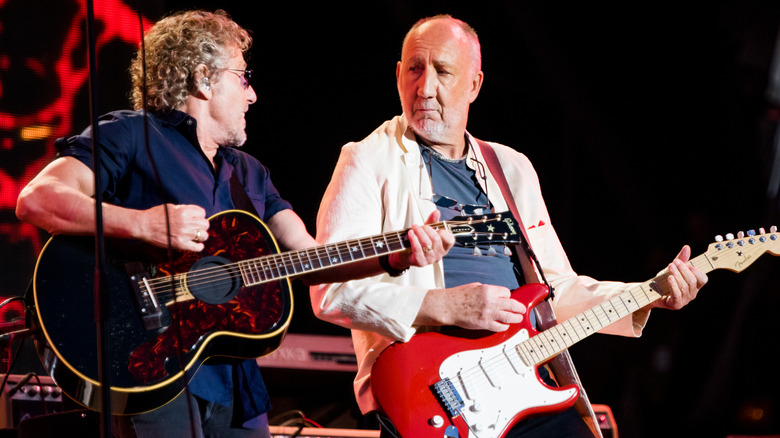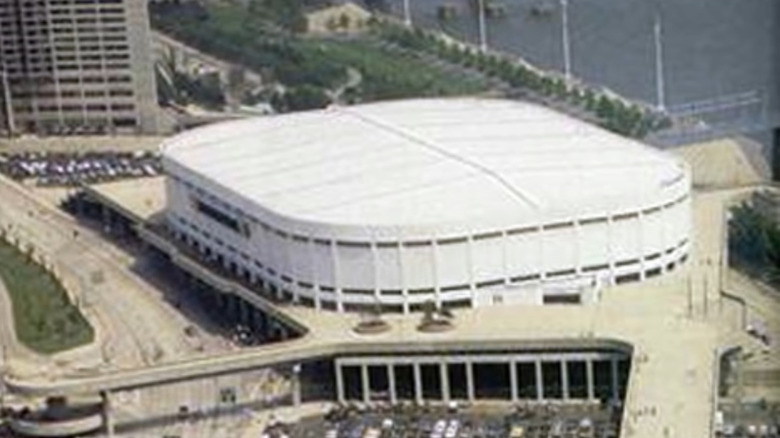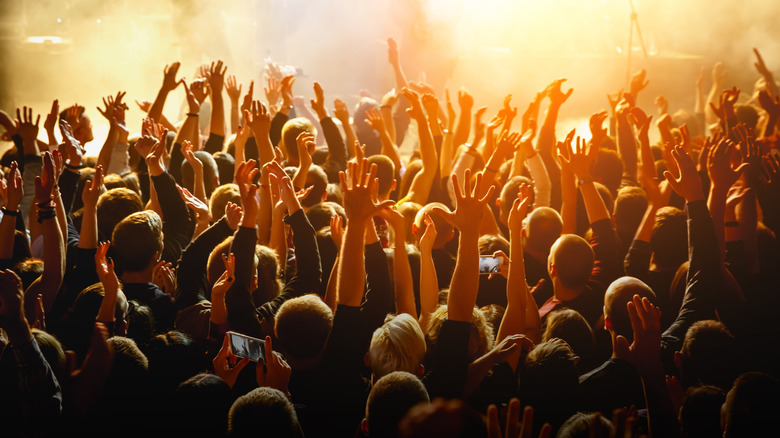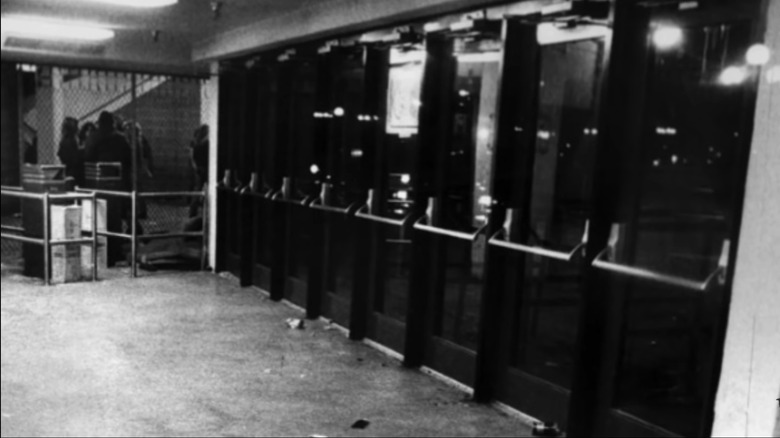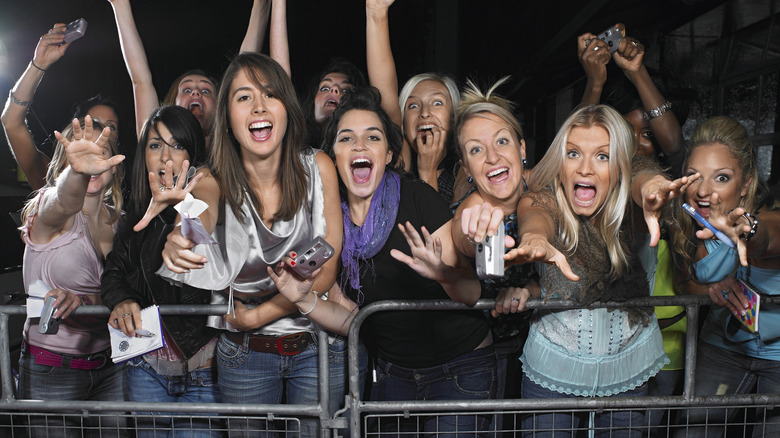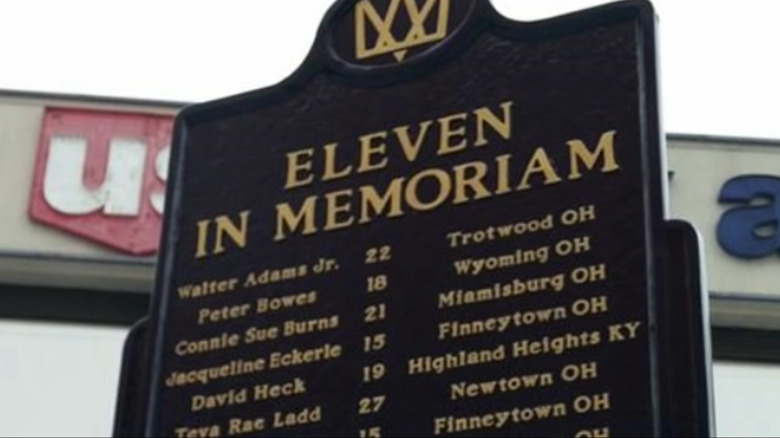The Who Concert Disaster Explained
"Our hearts are broken for those families and survivors in Houston. We know intimately what they are going through right now," said Fred Wittenbaum to the Cincinnati Enquirer. Wittenbaum's words were meant to comfort the families of those grieving the loss of loved ones who were killed in a "mass casualty event" while attending the Astroworld Festival in Houston. Eight people were killed and dozens more injured as Travis Scott, the touring festival's headliner, was performing. The New York Times described the Houston event as one of the deadliest "crowd-control" failures in the United States in some time. When it comes to disaster on that scale, though, memory lingers — and that's what seemed to be on Wittenbaum's mind.
In 1979, Wittenbaum had been a teen — just one of many lucky enough to venture out on a school night to see rock superstars The Who at Cincinnati's Riverfront Coliseum. As in the Houston disaster, that night's concert was "festival seating," essentially first-come-first-served, which allowed any ticket holder to stake their claim on whatever square foot of space they desired in a large, open area. Of course, most concert fans only have their eye on one place: as close to the stage as possible.
We called it animal seating — Riverfront Coliseum employee
In December of 1979, The Who were certified rock royalty. The group was on the second U.S. leg of a tour promoting their album "Who Are You," released the year before. The band's performance in Cincinnati was among the first handful of dates on that leg, per The Who Concert Guide. According to Rolling Stone, several thousand "reserved" seat tickets had been sold and nearly 15,000 festival-seating tickets had been sold for the concert at Riverfront Coliseum. At first, there was little indication the evening would turn out differently than expected. One of the men who worked for the gig's promoters had noted, though, that fans had begun to line up as early as 1:30 that afternoon, far ahead of the concert's billed 8 p.m. start.
By 6:30, according to the recollection of other witnesses to Rolling Stone, about 8,000 people had gathered near the building's bank of doors, some trying to escape the frigid air coming off the nearby Ohio River and others excited to hear The Who's soundcheck inside the Coliseum. The doors were not supposed to open to ticket holders until 7:00 p.m.
Festival seating makes money but at what cost
Festival seating, like that at The Who concert, was no anomaly. Though History notes that many venues had eliminated the controversial practice by 1979, Riverfront Coliseum had not — and likely for a specific and cynically expected reason: it made money. Despite the foreshadowing of a similar incident at a 1977 Led Zeppelin concert at the same venue, in which dozens were injured pushing against the entrance doors, the warning went unheeded.
Festival seating was a good deal for promoters. As Richard Klopp noted in what he called a "concerned citizen letter" he wrote following bad concert experiences in Cincinnati several years before The Who concert, "What this means for the promoter is more money; for the concertgoer ... this means that he'll probably have to sit in the aisles or on the floor ... jeopardizing his safety and the safety of others" (via Rolling Stone). He was proven right in the worst possible way as three years later, he and his wife (who both survived) would be swept up in the cruel events of that December night.
The concert hadn't even begun
According to History, around 7:00 p.m., a police lieutenant noted how many people were pressing forward to get close to just a few soon-to-be-open doors. When he approached the promoters with the solution of readying more entrances to better distribute the crowd, he was told by promoters that not enough ticket takers were working to enable them to open more sets of doors.
It was too late anyway. Around 7:20, the crowd surged and one set of doors shattered. Others were pushed open. With no visible security and too few police, the few trying to control the situation were simply overpowered. Concertgoers streamed through the entry en masse. It would be nearly half an hour before police could make their way through the crowd.
As attendee Mark Helmkamp later described the scene to Rolling Stone, "it was a slow squeeze, not a stampede. I was stuck in it for 45 minutes. I went down twice and wasn't sure that I would make it. I saw guys with blue lips – they couldn't get oxygen."
Phil Sheridan went on to describe the crush of people trying to get through turnstiles — some three at a time as ticket takers tried in vain to ask for their tickets. He went on to describe feeling a tug on his arm amid the crush of bodies, only to look down and see a young woman asking for his help. "It's this girl," he told Rolling Stone, "and her head was at my waist and she said, 'Excuse me, my feet are back there somewhere.' She was horizontal."
Assessing the aftermath
According to History, 11 people were killed by asphyxiation in the crush and dozens were injured. The scene was so horrifying, fire officials told the promoters to go on with the show because they feared riling up the crowd again. The Who played for hours and wouldn't even learn of the tragedy until after their final encore.
To someone fortunate enough to have never been caught up in the energy of a dangerous crowd, it almost seems unfathomable how something like this could happen. Disturbingly, as we've seen several times since (including in Houston most recently), it's not difficult for these kinds of events to occur despite how improbable they may seem.
Some might be surprised to learn that the majority of those killed in crowd incidents like these are actually squeezed rather than trampled, says ABC News. They even note that a crowd surge can be powerful enough to bend steel. It's no wonder, then, that the human body is so fragile in that scenario. A U.K. inquiry into a similar crowd crush scenario issued a report that was terrifying in its clinical simplicity: "Survivors described being gradually compressed, unable to move, their heads locked between arms and shoulders ... faces gasping in panic" the report read, "aware that people were dying [...] they were helpless to save themselves."
Laying blame on the guilty
As ABC News notes, crowd control experts shy away from using words like "stampede" or condemning the panic of those caught up in the situation because it implies the crowd is to blame. In reality, despite the very human causes, few individuals are rarely to blame. Instead, experts look to those who are supposed to be keeping the fans safe, such as the organizers, hosting venue, promoters, and security.
In the aftermath of the event, Cincinnati banned festival seating, though it lifted the ban some 24 years after the disaster, citing improvements in crown-control procedures, says History. Given recent events, though, cities may once again be reassessing its merits. As Cincinnatian Paul Wertheimer (who watched the news of that day in 1979 unfold and was moved to become an expert in crowd control) told the Los Angeles Times, the Houston incident was "preventable."
As the Cincinnati Enquirer noted, disasters such as these inevitably bring up painful memories for survivors of The Who concert disaster. That night, several of the victims had been just teenagers, three attending the same high school. In 2019, The Who's Roger Daltrey made a visit to that high school to meet with organizers of a scholarship fund in memory of those students. The visit represented a real moment of healing for many. Daltrey's bandmate Pete Townshend also announced that year that The Who would soon be returning to play Cincinnati for the first time in four decades. Though COVID delayed the original plans, countless Cincinnatians are eagerly awaiting when the band can make good on that promise — and no doubt hoping this time for a show that will be memorable for all the right reasons.
